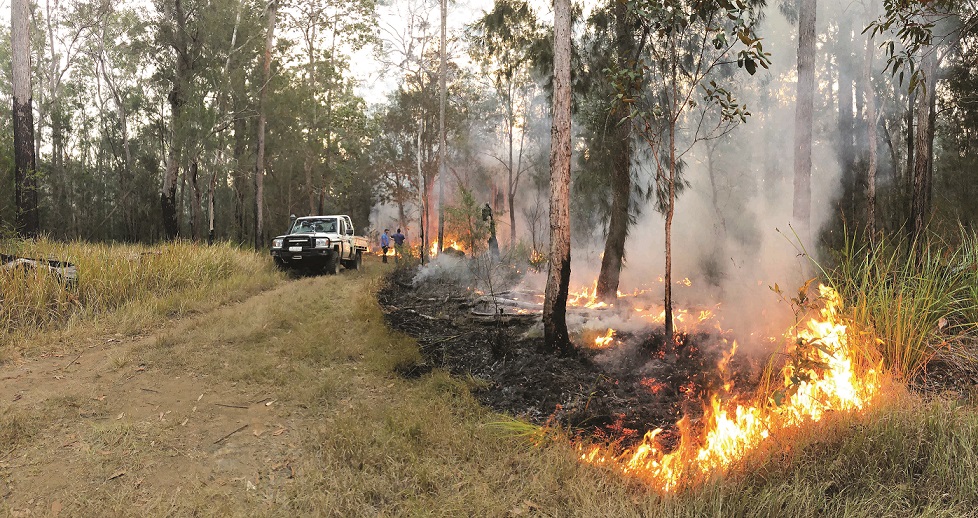By Tim White, Regional Operations Manager, and Peter Stanton, Ecologist – Fire and Vegetation
Northern Australia hosts some of the last great wild places on the planet. While parts of the landscape have been highly modified, Australian Wildlife Conservancy has the responsibility for managing some of the most intact remaining areas at our sanctuaries in north-eastern Australia. These include Wongalara, Pungalina-Seven Emu, Piccaninny Plains, Brooklyn and Mount Zero- Taravale Wildlife Sanctuaries – covering a total area of more than three quarters of a million hectares.
Fire management is integral to maintaining the ecological health of these environments. Aboriginal people traditionally survived in a fire-dependent landscape by meticulously using fire for many purposes, such as hunting and to travel through country, but above all, for the management of the fuel load around them. Conservation in the current era has many additional challenges, but in relation to fire management, AWC believes we should pay attention to the principles that have guided Aboriginal land management for tens of thousands of years, as well as to the insights of contemporary science and conservation practice.
The appropriateness of these principles was dramatically demonstrated during the summer of 2019-2020, when massive wildfires erupted across south-eastern Australia. They were of a scale beyond human memory and defied efforts at suppression. The loss of lives and the destruction of homes, habitats and wildlife was inestimable.
During the same period, at the height of the northern dry season, lightning ignited fires on four AWC sanctuaries in north-eastern Australia. Fortunately, they caused relatively little concern for managers, and apart from some efforts to halt their progress in strategically important areas, they eventually extinguished themselves. While differences in vegetation and the severity of fire weather contribute to these contrasting outcomes, AWC’s fire management program also played an important part.
 © Joey Clarke/AWC
© Joey Clarke/AWC
Context is key
AWC’s fire management is directed towards ensuring that the movement patterns of fire across the landscape are controlled through careful management and not by the capricious passage of wildfires. Beginning early in the year, numerous small fires are progressively lit to create a mosaic, denying wildfires large areas of long unburnt fuel and the ability to burn on long fronts. Our fire management is complex and varies according to the particular needs of habitat management and wildlife conservation at each sanctuary.
On Pungalina-Seven Emu Wildlife Sanctuary, in the remote Gulf of Carpentaria, the climate is dominated by long months of dry winds that originate from Australia’s arid inland. Here, the emphasis is on burning during conditions of high soil moisture, beginning with the first seasonal storms. This technique is also being trialled for the maintenance of native grasslands on Piccaninny Plains and in areas of wet sclerophyll forest on Brooklyn and Mount Zero-Taravale.
There is also a need to restore habitats threatened by the long exclusion of fire and weed invasion. This involves hot fires to control developing understories which, left unchecked, could eventually prevent regeneration of canopy species, such as in the wet sclerophyll forests of Mount Zero-Taravale and Brooklyn. Repetitive controlled burning is another important tool AWC uses for eliminating exotic species such as lantana and rubber vine. This fire program has been a critical component of the habitat restoration work undertaken by AWC to facilitate the reintroduction of the endangered Northern Bettong (Bettongia tropica) to Mount Zero-Taravale.
Outstanding outcomes highlight effectiveness of AWC’s approach
Across all our northern properties, AWC’s fire program has greatly reduced the incidence of late dry season wildfire. The extent of wildfire has been reduced by 44 per cent on Mount Zero-Taravale, 36 per cent on Brooklyn, 64 per cent on Piccaninny Plains, 66 per cent on Pungalina-Seven Emu, and an incredible 90 per cent on Wongalara.
Since 2013, AWC has also worked with neighbouring landholders (involving multiple tenures) to plan and implement a regional fire management program across 600,000 hectares in the Upper Mitchell catchment, coordinated out of Brooklyn Wildlife Sanctuary.
Highlighting the program’s success, wildfire has been reduced by 43 per cent across the region and the maximum area burnt in the late dry season in any one year has more than halved.
The fire programs at all AWC sanctuaries are subject to detailed plans that are regularly refined in accordance with our experience of landscape-scale controlled burning, robust measurement of fire patterns and our increasing knowledge acquired from plot-based monitoring. AWC is at the forefront of best-practice fire management across northern Australia, helping to reduce the extent and frequency of destructive wildfires and conserve Australia’s precious biodiversity.
Read and download this full issue of Wildlife Matters here.
Please help us reduce wildfires and protect wildlife